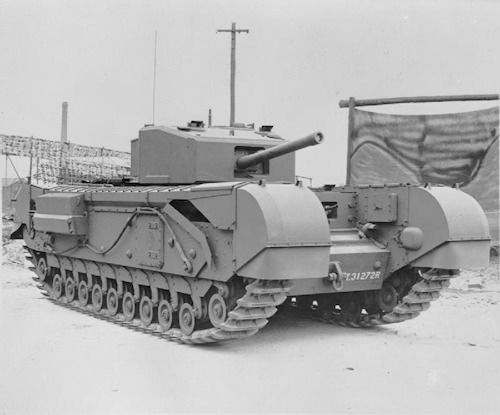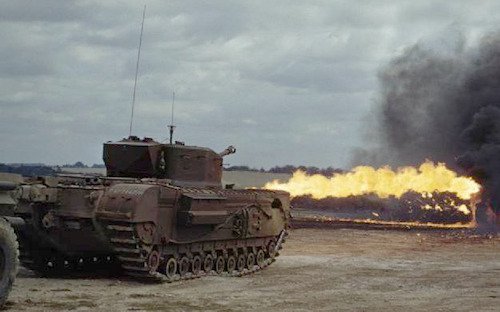Il Churchill it was one of the most important tanks for the infantry of the armored units of the British army. Designed at the beginning of the Second World War (around 1940), it was used - in addition to the British - also by the ground forces of the Commonwealth countries and by the Red Army. The vehicle turned out to be one of the heaviest Allied tanks during the conflict; numerous variants of the vehicle were built and almost 6000 specimens were built overall. It can be argued that it was one of the most significant tanks produced by the war industry in the United Kingdom.
It should be remembered that on the eve of the Second World War the British view on the use of tanks was more or less anchored to the 1918 approach; not dissimilar – perhaps even more antiquated – was the French view.
In Germany, General Heinz Wilhelm Guderian was forced to clash for a long time with the leaders of the Army General Staff who, although in some respects ahead of the British and French ones, did not fully accept his innovative ideas on the use of the tank .1 These new theories consisted of carrying out deep strategic penetrations with independent armored forces, deep tank raids intended to cut off the major communication routes of the opposing army well behind its front line.
 Finally, with the outbreak of hostilities, General Guderian was able to put his ideas into practice despite the misgivings of his superiors. In this regard BHLiddell Hart writes: “The battle of France is one of the most impressive examples offered by history of the decisive effect of a new idea, translated into practice by a dynamic performer”.2
Finally, with the outbreak of hostilities, General Guderian was able to put his ideas into practice despite the misgivings of his superiors. In this regard BHLiddell Hart writes: “The battle of France is one of the most impressive examples offered by history of the decisive effect of a new idea, translated into practice by a dynamic performer”.2
According to many scholars and military analysts, the effect proved to be similarly fundamental to those that crowned the implementation of other new theories in past historical periods: the use of the horse, the spear, the phalanx, the versatility of the legion, the bow , the horse archer, the musket, the cannon, the organization of armies into separate and maneuverable divisions. Perhaps, the idea of the tank turned out to be decisive in an even more timely manner.3
The first prototype of the Churchill was tested when the ruinous battle of France it was already over; the vehicle entered active service starting from 1941.
The British infantry tank - as already mentioned above - "suffered" many variations and was widely used during the war. In fact, the spaciousness of the vehicle and its compatibility with various terrains and different climates made it supremely "multifaceted".
The armament of the former Churchill (Mk i - opening photo - e II) consisted of a 2-pounder cannon, a Besa machine gun and a 3-inch howitzer. Later, later versions – Mk III (Photo) e IV - were upgraded with a 6-pounder gun and a 75mm gun. The Churchill Mk V it was equipped with a 95 mm howitzer; this vehicle was used as support artillery for the Mk IV, and to tank departments in general in war theatres. Other versions saw changes and refinements of a technical nature, always with 75 or 95 mm pieces.
 Using the hull and mechanics of the Churchill were built and used flamethrower tanks (il Churchill Crocodiles), wagons for support to landing troops, wagons with mortar, rescue wagons and demining wagons. During the war i Churchill were converted into armored vehicles Kangaroo.
Using the hull and mechanics of the Churchill were built and used flamethrower tanks (il Churchill Crocodiles), wagons for support to landing troops, wagons with mortar, rescue wagons and demining wagons. During the war i Churchill were converted into armored vehicles Kangaroo.
The British infantry tank was used in North Africa, in Italy, in the campaign of northwestern Europe and on the Eastern Front (used by the armored units of the Red Army).
Il Churchill it was 7,4 m long, 2,49 m high and 3,25 m wide. She weighed 39,1 tons (Mk I), 40 tons (Mark VII).
Armor: 102mm front hull, 76mm side hull, 51mm rear hull, 89mm front turret, 76mm side and rear turret (Mk I-Mk VI). 152 mm hull and turret front, hull sides, 95 mm turret sides and rear, 51 mm hull rear (Mk VII-Mk VIII).
Engine: Bedford 12 cylinder petrol engine, power 350 HP. The maximum speed was 24 km/h, while it was around 20 km/h for the versions Mk VII-VIII.
The tank could count on a crew of 5 men.
1 See PF Cazzani, The English Churchill tank, in Illustrated History n°219, 1976, p.118
2 BH Liddell Hart, Military history of World War II. Armies, fronts and battles. Mondadori, Milan,
2021, p.89
3 See, Ibidem, p.90
Photo: IWM / web












